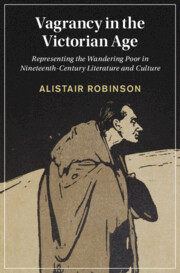Refine search
Actions for selected content:
25 results
5 - Relieving Famines
- from Text 5 - On Relieving the People’s Suffering
-
-
- Book:
- Chinese Statecraft
- Published online:
- 17 July 2025
- Print publication:
- 31 July 2025, pp 80-92
-
- Chapter
- Export citation
6 - The Other Side of the Hedge
-
- Book:
- Undercover
- Published online:
- 13 March 2025
- Print publication:
- 20 March 2025, pp 205-241
-
- Chapter
- Export citation
1 - Homelessness, Vagrancy Laws, and Municipal Ordinances
-
- Book:
- Homelessness, Liberty and Property
- Published online:
- 14 November 2024
- Print publication:
- 21 November 2024, pp 23-39
-
- Chapter
- Export citation
1 - Legalizing Queer Life
- from Part I - Queer Partners and Parents
-
- Book:
- Family Matters
- Published online:
- 27 May 2024
- Print publication:
- 01 August 2024, pp 31-61
-
- Chapter
- Export citation
1 - From Tramp to Hobo
- from Part I - Context
-
- Book:
- Vagabonds, Tramps, and Hobos
- Published online:
- 27 July 2023
- Print publication:
- 10 August 2023, pp 24-44
-
- Chapter
- Export citation
Chapter 2 - Marginality, Incivility and Degeneration in Elizabethan England and Ireland
-
- Book:
- Human Empire
- Published online:
- 14 April 2022
- Print publication:
- 21 April 2022, pp 61-102
-
- Chapter
- Export citation

Vagrancy in the Victorian Age
- Representing the Wandering Poor in Nineteenth-Century Literature and Culture
-
- Published online:
- 02 November 2021
- Print publication:
- 14 October 2021
Chapter 4 - Loafers
- from Part II - The City
-
- Book:
- Vagrancy in the Victorian Age
- Published online:
- 02 November 2021
- Print publication:
- 14 October 2021, pp 130-160
-
- Chapter
- Export citation
Introduction
-
- Book:
- Vagrancy in the Victorian Age
- Published online:
- 02 November 2021
- Print publication:
- 14 October 2021, pp 1-24
-
- Chapter
- Export citation
Chapter 6 - Beachcombers
- from Part III - The Frontier
-
- Book:
- Vagrancy in the Victorian Age
- Published online:
- 02 November 2021
- Print publication:
- 14 October 2021, pp 195-221
-
- Chapter
- Export citation
Chapter 5 - Paupers, Vagabonds and American Indians
- from Part III - The Frontier
-
- Book:
- Vagrancy in the Victorian Age
- Published online:
- 02 November 2021
- Print publication:
- 14 October 2021, pp 163-194
-
- Chapter
- Export citation
Chapter 1 - Gypsies, Hawkers and Handicraft Tramps
- from Part I - The Country
-
- Book:
- Vagrancy in the Victorian Age
- Published online:
- 02 November 2021
- Print publication:
- 14 October 2021, pp 27-57
-
- Chapter
- Export citation
Afterword: London 1902
-
- Book:
- Vagrancy in the Victorian Age
- Published online:
- 02 November 2021
- Print publication:
- 14 October 2021, pp 222-228
-
- Chapter
- Export citation
Chapter 3 - Casual Paupers
- from Part II - The City
-
- Book:
- Vagrancy in the Victorian Age
- Published online:
- 02 November 2021
- Print publication:
- 14 October 2021, pp 91-129
-
- Chapter
- Export citation
Chapter 2 - Poachers
- from Part I - The Country
-
- Book:
- Vagrancy in the Victorian Age
- Published online:
- 02 November 2021
- Print publication:
- 14 October 2021, pp 58-88
-
- Chapter
- Export citation
Vagrant Servants as Disease Vectors: Regulation of Migrant Maidservants in Fin-de-Siècle Vienna
-
- Journal:
- Austrian History Yearbook / Volume 51 / May 2020
- Published online by Cambridge University Press:
- 16 March 2020, pp. 152-172
- Print publication:
- May 2020
-
- Article
- Export citation
9 - Girls, Young Women and Crime
- from Part III - Representation of Crime
-
-
- Book:
- Women's Criminality in Europe, 1600–1914
- Published online:
- 10 January 2020
- Print publication:
- 30 January 2020, pp 173-188
-
- Chapter
- Export citation
4 - Policing the Expanding Sex Trade
- from Part II - Regulating and Policing the Sex Trade
-
- Book:
- Bawdy City
- Published online:
- 06 December 2019
- Print publication:
- 02 January 2020, pp 111-145
-
- Chapter
- Export citation
7 - Others
- from Part III - Criminal Responsibility in Relation
-
- Book:
- Self, Others and the State
- Published online:
- 11 November 2019
- Print publication:
- 12 December 2019, pp 193-220
-
- Chapter
- Export citation
Part III - Criminal Responsibility in Relation
-
- Book:
- Self, Others and the State
- Published online:
- 11 November 2019
- Print publication:
- 12 December 2019, pp 163-252
-
- Chapter
- Export citation
